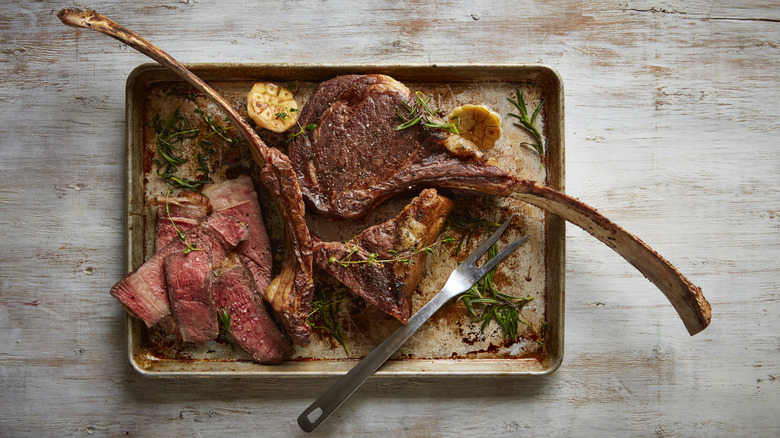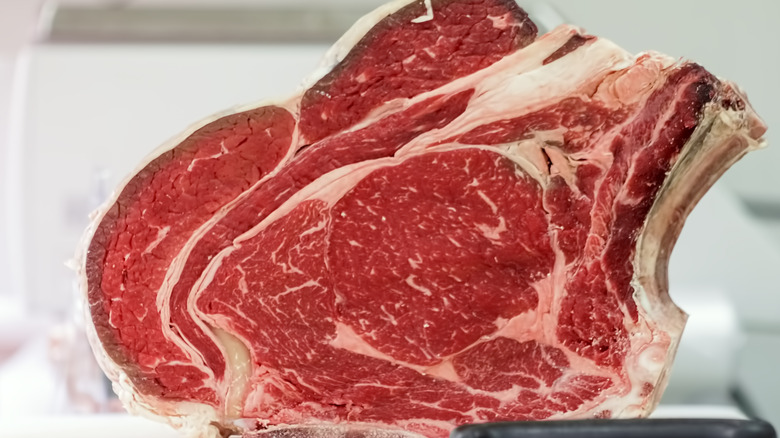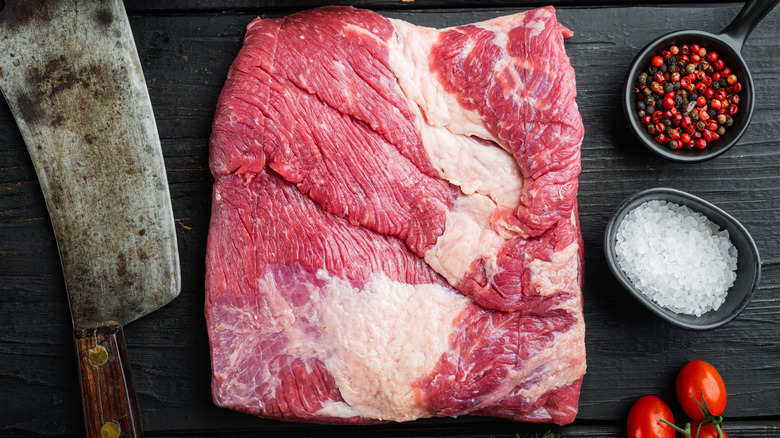What Does A Deckle Of Beef Really Mean?
If you're a beef enthusiast, chances are you already know about most of the major cuts, including the sirloin, skirt, and, of course, the luxurious ribeye. But there are other cuts of beef that you might have heard tossed around, one of which includes the deckle. Not only is that a fun word to say out loud, but it's also one of those under-the-radar cuts that professionals like butchers enjoy — and if the pros love it, it's worth knowing about.
A deckle of beef is a cut also known as a ribeye cap or rib cap. The term "ribeye cap" isn't exactly a household one either, but if you've ever eaten an entire relatively easy-to-cook ribeye steak (double points if it's Wagyu), you have most certainly partaken in the joy of a ribeye cap. That's because, as the name implies, this cut is part of a ribeye. More specifically, it's the outer layer of the steak that's separated by a wall of fat that "caps" part of the cut (and can also hang over the side of the steak). Because it's just a portion of a larger cut, you may have happily chowed down on it as part of the steak without noticing its special characteristics. What's confusing, however, is that the word "deckle" can also refer to part of the brisket, but decidedly not a prized section that anyone should seek out.
What makes a deckle of beef so special
The cooked deckle is a very small section of a ribeye, but it's 100% worth seeking out for its tenderness and distinctly beef flavor (I know, this is like describing a nut as "nutty"). Because it's just a small percentage of a larger cut, I think it's worth removing to savor on its own. Once a ribeye is cooked, you can easily take a knife and slice around the fat border separating the deckle from the eye (the major center portion) to remove it. Then you can eat it separately and appreciate it for what it is.
You can, in fact, ask a butcher for just the rib cap, but it will likely cost you a premium — a 1,000 pound steer might net you three pounds of rib cap, if you're lucky. Restaurants rarely serve it on its own either, which is why you have to specially order it. Since it's not particularly thick, this is a cut of beef you can cook using a high-heat method. No reverse sear here, as a regular one (like this straightforward 3-3-2-2 method) should do just fine.
What the term deckle can also mean
The other version of the word "deckle" when it comes to beef isn't nearly as appealing as the ribeye cap version. A deckle can also be taken to mean the relatively hard layer of fat and meat just inside a brisket, which holds the meat to the ribcage of the steer. It's removed to create a full packer brisket, which contains both the flat and point, the two sections of a brisket that we more typically eat.
Here's where it gets triple confusing: People sometimes also call the brisket point, which is the fatty and marbled section of the brisket, the deckle. I somehow doubt they're serving you a slab of hard fat for dinner, however, so if someone casually refers to a piece of brisket as the deckle, it's likely a tender and flavorful cut that falls apart at the touch of a fork. Either way, if you're getting any kind of deckle (provided it's not, uh, the trim), just know you're about to eat well. And the next time you get a ribeye, try taking that cap off to try it by itself. You may discover your new favorite cut of beef.


